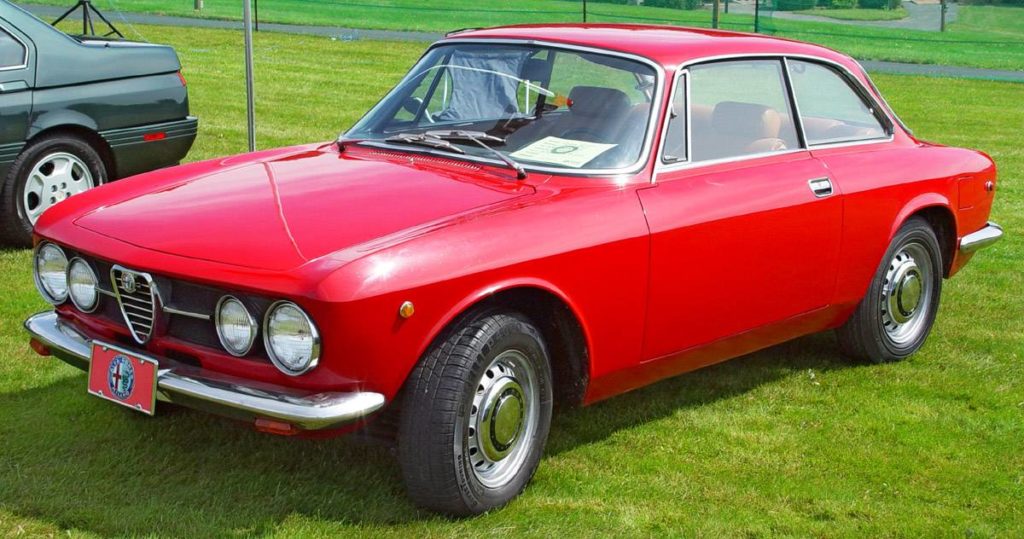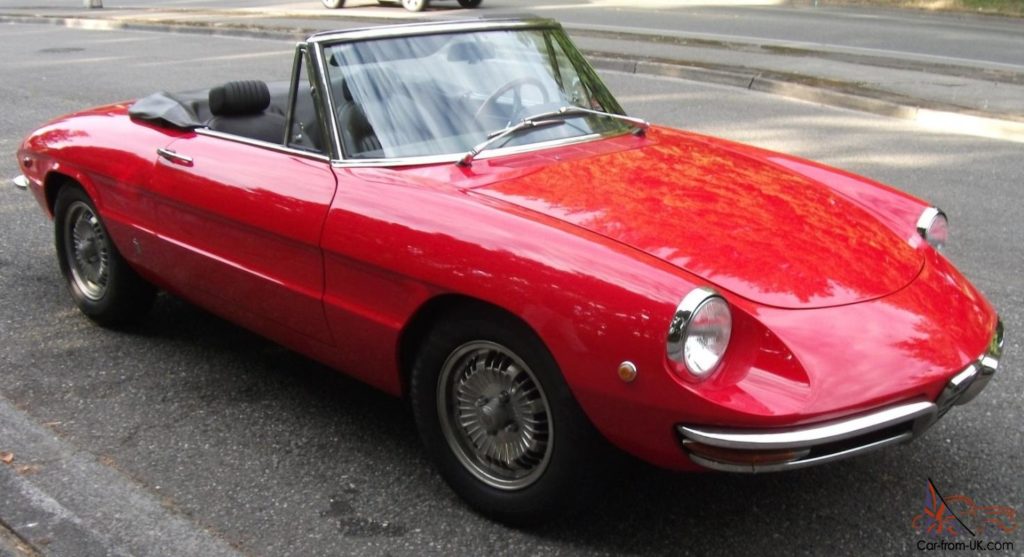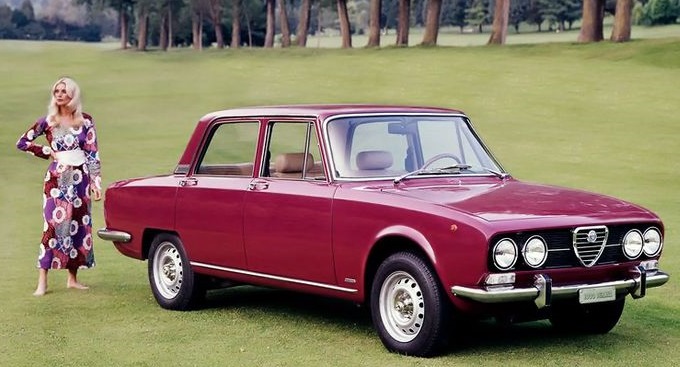Most men like powerful cars (e.g. Jeremy Clarkson: “POWWWWERRRRRR!”), and among the power-hungry there is a common thought nowadays that a 3-liter six-cylinder engine is the basic starting-point for any performance car, and four-cylinder engines are inferior (hence nicknames like “four-banger” and the like).
Not so.
Back in the late 1960s, Alfa Romeo came up with a four-cylinder engine of only 1,779 cubic centimeters (actually rounded down to the 1750 nomenclature, unlike the standard Italian exaggeration) which was an absolute screamer. So efficient and racy was it that they used the same engine across all their “105” chassis models; the GT Veloce:

…the Spyder:

…and even the Berlina sedan model (with a human figure, for scale):

Ahem.
I’ve driven all three, and not once did I ever say to myself, “Oh, if only this were a 3-liter six!”
The point was that all three models were lightweights, and the four-cylinder engine was perfectly adequate for the task — which in each model was to go fast, and they did. And in normal Alfa Romeo fashion, they went through corners as though on rails, and the peppy little four-banger engine and five-speed short-throw gearbox made every trip an adventure.
Provided that they started, or didn’t lose non-essential parts like rearview mirrors, door handles and what-have-you along the way. (I once had the experience of the interior mirror coming off in my hand as I was adjusting it.)
I also once drove a Marauder (Lotus 7 knock-off) equipped with the 1750 engine. Now the Alfa GTV was no heavyweight, coming in at just around a ton, but the fiberglass-bodied Marauder could be lifted with ease by only two men, and carrying no weight at all, so to speak, the 1750 engine was a monster. I actually lifted off the throttle at the end of the Kyalami racetrack straight, whereas with the GTV I’d always been able to keep the pedal to the floor to make the first right-hand corner.
Four-banger? Sheesh. (Of course, the main reason for a four-cylinder-engined car’s poor performance nowadays has nothing to do with the lack of powerpower, but with the extra weight that has to be added to all cars because of all the safety regulations that have been mandated by Nanny Gummint since the 1970s. But I won’t discuss that topic further as I’ve just finished clearing up the wreckage from my last RCOB episode.)
I love the 105 Alfa Romeos and their 1800cc engines, all of them. I would drive one today quite happily.

I had a FIAT X1/9 which was an absolute blast to drive. They say that it is more fun to drive a slow car fast, than a fast car slow (ly), and there is a certain amount of truth to that. I put nice looking wheels on it instead of the grotty steel wheels that came with it. It had, I think, about a 9 gallon gas tank and you would always be stopping for gas, as the mileage was poor for a 1.3 liter engine.
I never have driven an ALFA (another acronym), but always admired the dual overhead cam engine in the 60s, versus the tractor engine that was in my Triumph.
I have been spoiled these days as I have become fond of engines that start in any weather, unlike certain older British cars I could mention. (all of them).
Had an Alfa 1750 Sedan (white) when we lived in Italy in 1970-73. Fun to drive but you’re spot on re quality control. But then an it was an Italian car. Darn thing was stolen twice, last time it was used as a getaway car in a robbery according to the Carabinere. Fast and handled well.
https://www.youtube.com/watch?v=fDaONrHK1f8
I was going to post that, but you beat me to it!
This one’s an Alfa Romeo, Kim, and small displacement 2.0 l, but it is a V8–a 1968 Alfa 33 Stradale. I bet you’d love it:
https://youtu.be/0JXJr-jtit8
I never considered the term “four banger” to be pejorative, simply descriptive.
When I was in High School the common car for guys in my area was a 10+ year old (i.e. mid-late 60’s) American muscle car as that was available and affordable. We used 4 Banger and 6 Banger regularly to describe engines in our cars (I don’t think anyone had an 8 cylinder).
Regional dialects?
Don’t forget the GTA. It was an aluminum bodied GTV with plexiglas windows to save weight.
By all means, do of course feel free to appreciate those marvels of Italian design.
Please remember the iron rule of Italian cars – “Look but don’t touch”.
If you must have a four pot AND the desire to actually arrive somewhere, then might I suggest an E30 M3? Agreed on no level does it deliver the same aesthetic appeal, but as a real world choice, yes, every time.
Try driving the BMW i8. It has a three cylinder engine.
I had a 1988 Spider, you can see part of it in my avatar. It didn’t have the 1750, but my 2-liter had many of the same innovations. Hell, the 1750 had many of the same innovations as the 1600 that was put into ALFA’s street cars in 1966. Dual overhead cams, twin Weber two-barrel carbs, wet sleeve pistons, 7-quart (!) finned aluminum oil sump….all of these were standard fare. That 1600 made 100 hp, about 1 hp per cubic inch, which was an American street rodder’s dream. When I hear some car manufacturer touting their variable valve timing in their “modern” engine, I have to laugh. ALFA used that tech in their 2-liter engine starting in 1981!
I loved my Spider and drove it to work most days. I foolishly over-revved it one morning and that was the beginning of the end. One day, the connecting rod stopped clicking and started knocking, signifying the end of the engine. It sat in the garage for five years and, as Italian sports cars do, it became more of a liability than I was willing to tolerate. I found an optimistic young man who was good with a wrench and sold him the broken car and all of my spares. He left smiling, but hadn’t informed his wife of his purchase….
I had a 76 Fiat Spyder. The same engine was offered in a Ferrari but with a turbo. I upgraded my Fiat to the Ferrari specs. I went from 147 hp to just over 300 on a car that weighed 2200 pounds. That was a fun car.